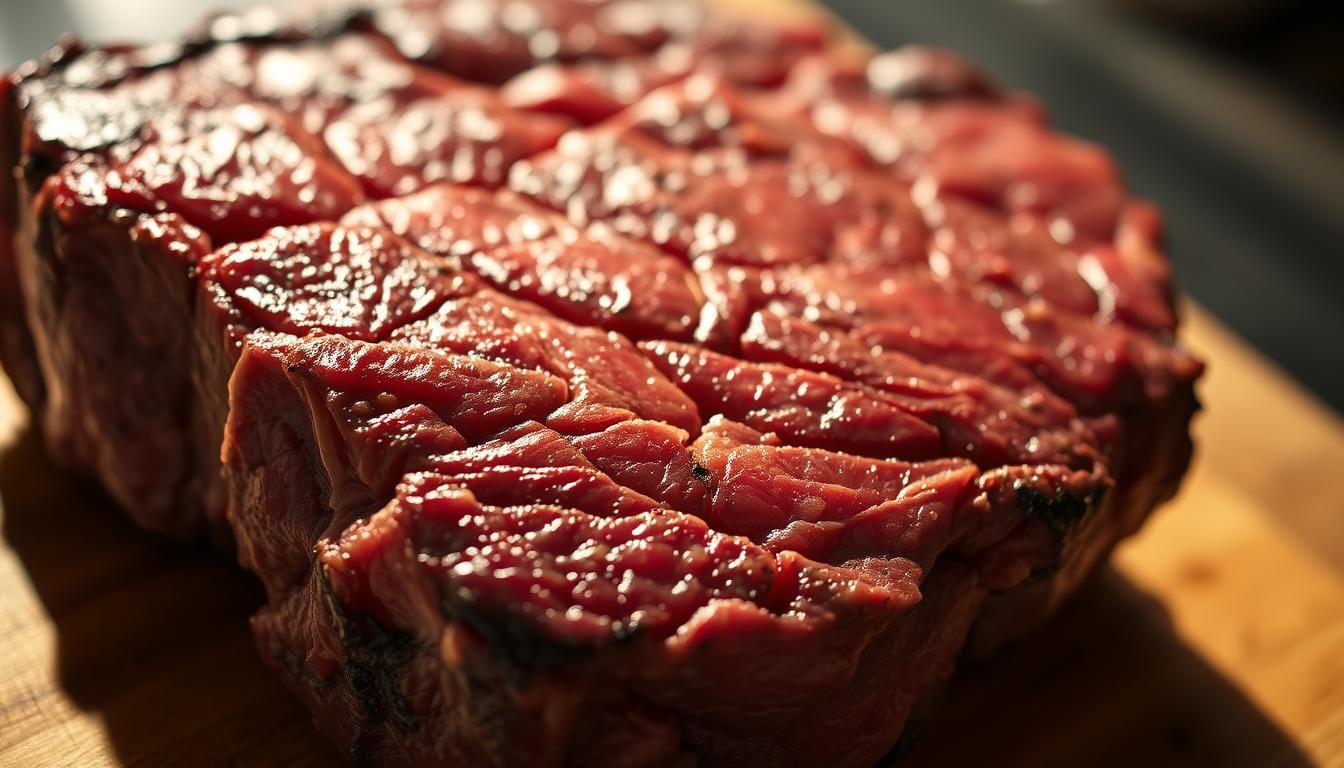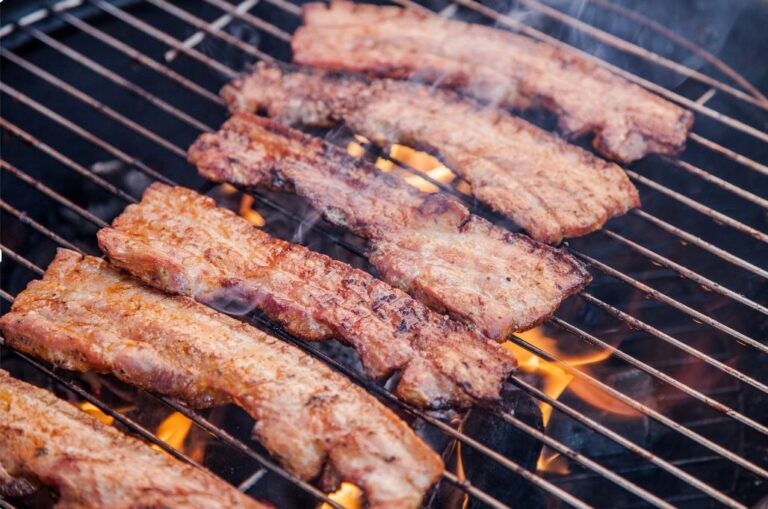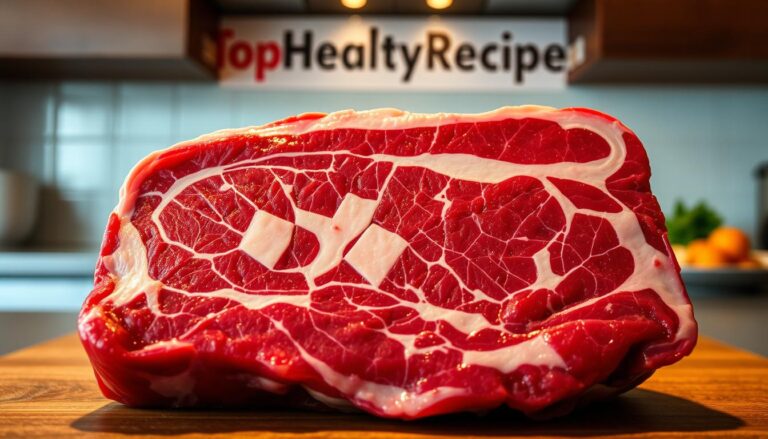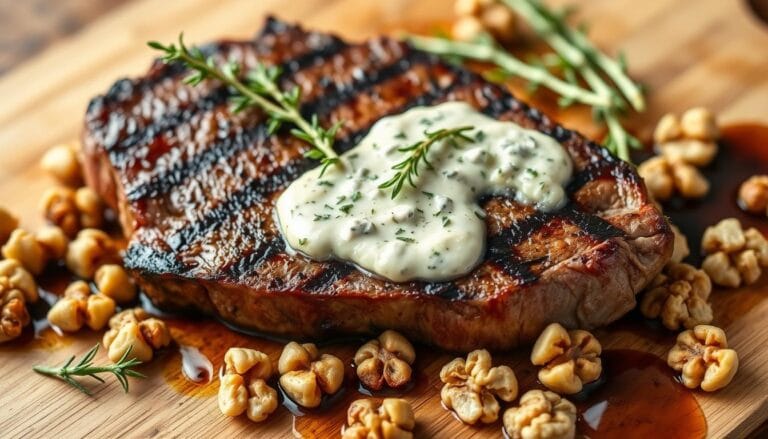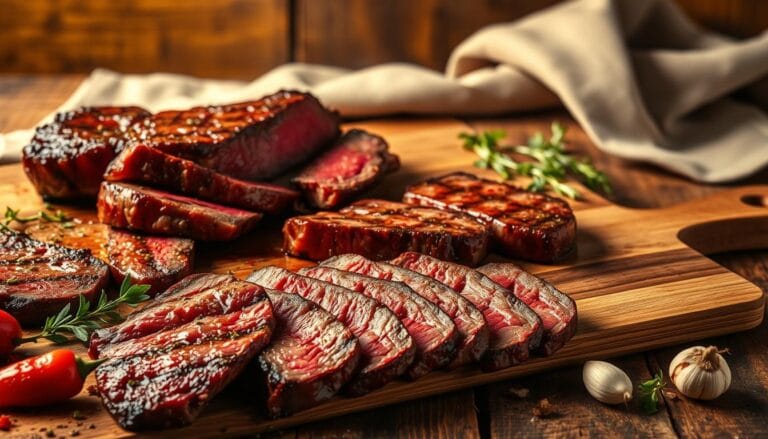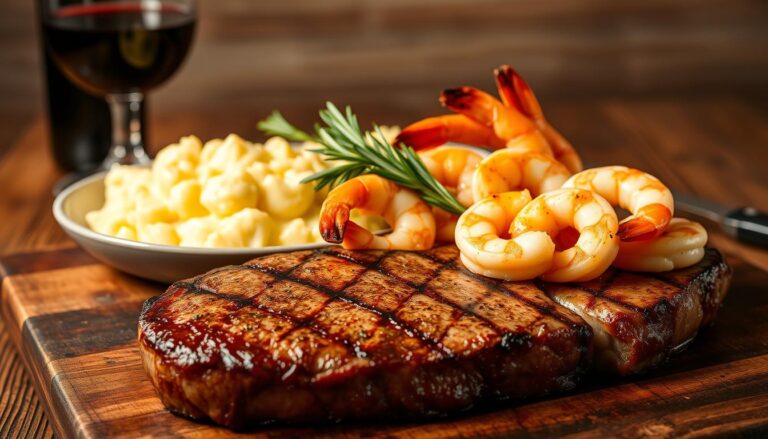Aged Steaks: Why They’re Juicier, More Tender, and Flavor-Packed
Table of Contents
Aged Steaks: Why They’re Juicier, More Tender, and Flavor-Packed
Imagine enjoying a tender, juicy steak with deep, rich flavors. For many, this dream comes true with aging. Whether you’re a grill pro or a foodie, learning about aging can make your meals better.
Aging turns regular meat into a special treat. It lets the steak’s natural enzymes work, making the flavors more complex. As you learn about aged steaks, you’ll see why they’re a top choice for food lovers.
Key Takeaways
- Understand the science behind aging and its impact on steak quality.
- Learn how to select the perfect aged steak for your next meal.
- Discover practical tips for preparing and serving aged steaks.
- Explore the different types of aging and their unique characteristics.
- Enhance your dining experience with expert advice on pairing aged steaks.
What Are Aged Steaks?
Steak lovers often talk about ‘aged steaks.’ But what does it mean? Aged steaks are meat cuts that sit for a while. This lets natural processes tenderize the meat and make its flavors stronger.
The Aging Process Explained
Aging steak means letting natural enzymes break down proteins and fats. This can take days to weeks. It makes the meat tender and flavorful.
The enzymes like cathepsins and calpains are key in this change. As the steak ages, muscle fibers and connective tissues break down. This makes the meat tender. Also, as moisture evaporates, the meat’s flavors become more intense.
Types of Aging: Dry vs. Wet
There are two main aging methods: dry aging and wet aging. Dry aging lets the steak sit in a controlled area where air circulates. This makes the meat lose moisture and intensify its flavors. It’s known for its nutty flavor profile.
Wet aging involves aging the steak in vacuum-sealed bags. This method keeps more moisture, making the steak tender. The flavor is more subtle than dry aging.
| Aging Method | Characteristics | Flavor Profile |
|---|---|---|
| Dry Aging | Meat is exposed to air, losing moisture. | Complex, nutty, intense. |
| Wet Aging | Meat is aged in vacuum-sealed bags. | Tender, subtle flavor enhancement. |
Why Aging Enhances Flavor
Aging steaks makes their flavors stronger. As moisture evaporates, the remaining flavors become more intense. The enzymes also add to the meat’s rich, complex taste.
Knowing about aging steaks and its methods can make you appreciate high-quality steaks more. Whether you like the bold flavors of dry-aged steaks or the tender texture of wet-aged ones, understanding the aging process can enhance your steak experience.
Benefits of Aged Steaks
For those who love premium steaks, aged steaks offer unmatched taste and texture. Dry aged steaks, in particular, undergo a transformation that boosts their natural qualities. This process makes the steak tender and intensifies its flavors, making it a favorite among steak lovers.
Improved Tenderness
The aging process breaks down proteins and fats in the meat, making it tender. As the steak ages, enzymes in the meat break down connective tissues. This makes the steak more enjoyable to eat, even from tougher cuts.
Richer Flavor Profile
Dry aging concentrates the steak’s flavors by removing moisture. This process creates complex flavors, often described as umami, nutty, or funky. The result is a richer, more complex flavor profile that enhances the dining experience.
| Aspect | Dry Aged | Wet Aged |
|---|---|---|
| Tenderness | Improved due to enzymatic breakdown | Moderately tender |
| Flavor Profile | Complex, concentrated, and intense | Milder, less concentrated |
| Texture | More tender and firmer | Can be softer and more prone to tearing |
Choosing the Right Cut for Aging
Starting a journey to a perfectly aged steak means picking the right cut. This choice greatly affects the steak’s quality. Knowing the characteristics of different cuts is key when aging steaks at home or buying dry aged ones.
Popular Cuts for Aging
Some cuts are better for aging because of their marbling and fat. Favorites include the dry aged ribeye, strip loin, and porterhouse. These are loved for their marbling, which makes the steak taste better and feel softer during aging.
The dry aged ribeye is known for its rich taste and tender feel. Its marbling makes the steak juicy and adds to its complex flavors.
Fat Content and Its Importance
Fat content is vital in the aging process. The fat cap outside and the marbling inside are key. The fat cap keeps the meat moist, while marbling adds flavor and keeps it juicy.
Choosing a cut with enough marbling is important. Leaner cuts might dry out too quickly. Also, whether to choose bone-in or boneless steaks can impact aging. Bone-in cuts can add more flavor and keep the meat moist.
When buying dry aged steaks or aging them at home, start with high-quality beef. This ensures a good base for aging.
How to Age Steaks at Home
To dry age steak at home, you need to mimic a pro’s aging setup. This means creating a special area for aging. It must have the right temperature, humidity, and air flow.
Setting Up Your Aging Environment
Controlling the environment is key to dry aging success. You’ll need a fridge that stays between 34-38°F. Keep humidity at 75-85% to avoid too much moisture loss and stop bacteria from growing.
Also, air movement is important. Use a fan to gently circulate air around the steak.
If you want to invest, there are aging bags or chambers made for this purpose. They help keep the right conditions and prevent contamination.
Duration: How Long to Age
The aging time depends on how intense you like the flavor. Dry aged steaks fall into three aging periods:
- 7-14 days: A slight boost in flavor and tenderness.
- 21-30 days: More noticeable flavor.
- 45+ days: Very intense flavor, but loses more moisture.
It’s important to know the balance between aging time, flavor, and moisture loss. This helps you choose the right aging time for your taste.
With the right aging setup and time, you can make a dry aged steak at home. It not only tastes better but also becomes more tender, making your meal even more enjoyable.
The Science Behind Steak Aging
Aging steaks is more than just letting meat sit. It’s a detailed process that involves enzymes and careful control of moisture and temperature. This turns raw beef into a tender, flavorful dish that many love.
The aging process uses the meat’s natural enzymes. Enzymes like calpains and cathepsins are key in breaking down muscle proteins, making the meat tender. As they work, they turn proteins into smaller pieces, adding to the steak’s rich flavor.
Enzymatic Activity in Meat
The enzymes’ work is critical in aging. They break down proteins, making the meat tender. Meat scientists say this process is a complex mix of enzymes and proteins.
Moisture loss is also key in aging. As moisture evaporates, flavors become more intense. But too much loss can ruin the texture. So, finding the right balance is important.
The Role of Moisture and Temperature
Temperature control is also vital. Maintaining a consistent refrigerated temperature between 34°F and 38°F (1°C and 3°C) is best. It slows down bacteria and lets enzymes work well. This careful control ensures the aging process is safe and effective.
The mix of enzymes, moisture control, and temperature precision creates the complex flavors and tender texture of dry aged beef. Knowing these science facts can deepen your respect for the skill in making aged steaks.
Identifying Quality Aged Steaks
To truly appreciate aged steaks, you need to know how to distinguish between high-quality and subpar products. Evaluating the quality of aged steaks involves a combination of visual inspection, texture assessment, and olfactory evaluation.
Color and Texture Indicators
When examining an aged steak, the first thing to notice is its color. Properly aged beef typically develops a deep red or burgundy color on the exterior, which may darken further during the aging process. The exterior may also develop a dry, sometimes moldy crust, which is usually trimmed away before cooking. In terms of texture, a quality aged steak should feel firm to the touch, reflecting the concentration of flavors and moisture loss during aging.
- The steak should have a firm texture.
- A dry, sometimes moldy exterior crust is normal.
- Deep red or burgundy color indicates proper aging.
Smell: A Key Component
The aroma of an aged steak is a key indicator of its quality. A well-aged steak should have a nutty, earthy aroma, sometimes accompanied by funky notes that are a result of the aging process. It’s important to differentiate between the desirable aromas and those that indicate spoilage. Avoid steaks with off-putting or sour smells, as these are signs that the meat has gone bad.
- Look for nutty and earthy aromas.
- Funky notes can be present but should not be overpowering.
- Avoid steaks with sour or off-putting smells.
By paying attention to these visual, textural, and olfactory cues, you can confidently identify high-quality aged steaks. This is true whether you’re purchasing them or evaluating the results of your own aging experiments at home.
Purchasing Aged Steaks
Steak lovers know the joy of finding the perfect aged meat steak. Aged steaks have a rich flavor and tenderness that’s unmatched. Whether you’re a pro chef or a home cook, knowing where to buy and how to pick aged steaks is key.
Where to Buy High-Quality Aged Steaks
High-quality aged steaks are available at many places. Specialty butcher shops are a great starting point. They offer a wide range of dry aged steaks and knowledgeable staff to help you.
High-end grocery stores with meat departments are also a good choice. They often have aged steaks that are well-stored and handled. Online meat retailers are popular too, letting you shop from home and have steaks shipped to you.
Fine dining steakhouses that sell retail cuts are another option. They offer steaks aged and handled by experts.
What to Look for When Buying
When buying aged steaks, look for proper packaging. Steaks should be vacuum-sealed or wrapped without moisture or leaks. It’s also important to check the aging time certification.
A well-aged steak should have a rich color and look tender. Its aroma should be deep and beefy, without any bad smells. Aged steaks are pricier, costing 25-50% more than non-aged ones.
Consider the aging type too. Dry aging steaks have a more complex flavor, while wet aging makes them tenderer. Knowing this helps you choose based on your taste.
- Check the fat content and distribution, as it affects both flavor and tenderness.
- Ask your butcher about their aging process, including the method, duration, and handling practices.
- Be aware of seasonality; certain times of year may offer better selection or value due to supply chain factors.
Cooking Techniques for Aged Steaks
Cooking aged steaks needs a careful touch to unlock their full taste. Dry-aged ribeye and other steaks have flavors and tenderness enhanced by aging. To cook them right, knowing the best methods and how to season is key.
Ideal Cooking Methods to Enhance Flavor
High-heat methods are best for cooking dry-aged steaks. They sear the outside fast while keeping the inside juicy. Cast iron searing, grilling, or broiling are top choices. These methods create a quick crust that locks in flavors and juices.
Cast Iron Searing: Heat a cast iron skillet to 450°F to 500°F. Use a thermometer to check the heat. Sear the steak for 1-2 minutes each side, then finish in the oven for the right doneness.
Grilling: Grilling adds a smoky taste that goes well with dry-aged steaks. Preheat the grill to high heat. Sear the steak for 2-3 minutes each side. For thicker steaks, finish cooking over lower heat to avoid burning.
| Cooking Method | Temperature | Cooking Time (per side) |
|---|---|---|
| Cast Iron Searing | 450°F – 500°F | 1-2 minutes |
| Grilling | High Heat | 2-3 minutes |
| Broiling | High Heat | 2-3 minutes |
Recommended Seasonings and Marinades
Seasoning dry-aged steaks should be light. The aging process creates a rich flavor that can be lost with heavy seasonings. Salt and pepper are usually the best choice to let the steak’s natural taste stand out.
For a bit more flavor, try a light olive oil brush and a sprinkle of garlic powder or paprika. Use acidic marinades sparingly, as they can alter the steak’s texture.
Using a meat thermometer is key to perfect doneness. Cook dry-aged steaks to 130°F – 135°F for medium-rare. Let the steak rest a few minutes before serving to keep the juices inside.
Pairing Aged Steaks with Side Dishes
Pairing aged steaks with the right side dishes can make a meal unforgettable. A high-quality, dry-aged steak deserves sides that enhance its flavors. You want to choose accompaniments that add to the taste, not overpower it.
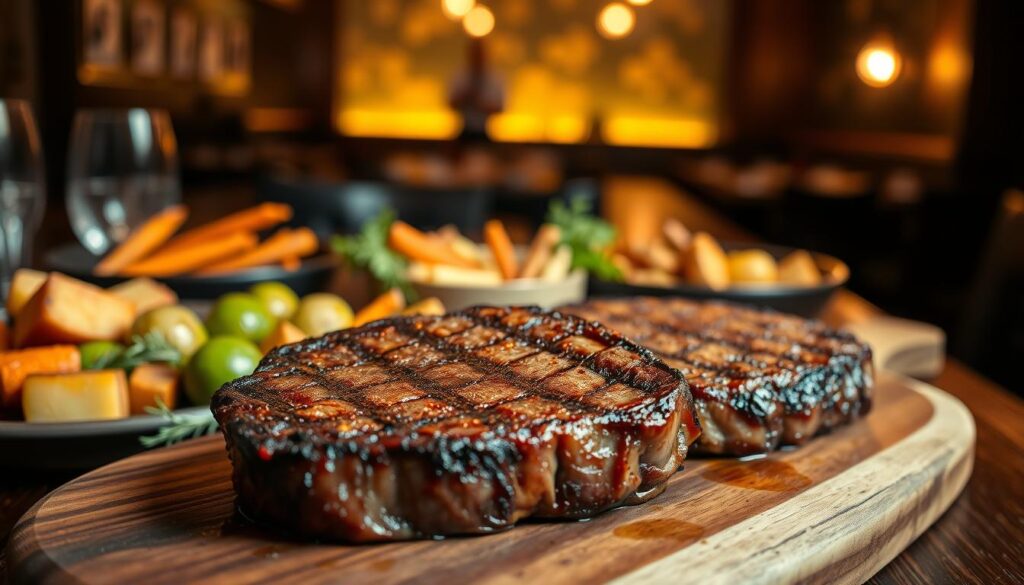
Complementary Sides
Classic steakhouse sides are loved for a reason. They match the bold flavors of aged beef perfectly. Creamed spinach offers a creamy contrast to the steak’s savory taste. Roasted mushrooms, like shiitake or oyster, add an earthy flavor that complements the steak’s umami.
For a modern twist, try roasted bone marrow or charred vegetables. They add a delightful texture to your meal. Starches like potatoes are also great. They provide a satisfying contrast and soak up the steak’s juices. Whether mashed, roasted, or as potato gratin, they’re a perfect match.
Wine Pairing for Aged Steaks
Choosing the right wine for your aged steak can enhance your dining experience. Full-bodied red wines, like Cabernet Sauvignon, Malbec, or Syrah, are perfect. They match the steak’s bold flavors, creating a balanced taste.
For those who don’t drink wine, there are other options. Craft beers, such as stouts or porters, can pair well with aged beef. A glass of bourbon adds smoky, vanilla notes that complement the steak. Even non-alcoholic drinks, like artisanal sodas or flavored sparkling water, can refresh your palate between bites.
“The right pairing can elevate the dining experience, making even the simplest meal feel like a special occasion.”
Storing Aged Steaks Properly
To enjoy your dry aged steak at its best, it’s essential to understand how to store it properly. Dry aged steaks have concentrated flavors and tender textures. They require careful handling to maintain their quality.
A key factor in storing dry aged steaks is their reduced moisture content. This affects how they should be stored in the refrigerator or freezer. Proper storage techniques will help preserve the steak’s quality and flavor profile.
Refrigeration Techniques
When refrigerating dry aged steaks, it’s important to balance humidity and prevent moisture from accumulating. This can lead to spoilage. Wrapping the steak in butcher paper is recommended as it allows for airflow while protecting the meat.
Avoid using plastic wrap or vacuum sealing for long-term storage in the refrigerator. These methods can prevent the steak from breathing and may cause it to become overly moist.
For optimal storage, place the wrapped steak on a wire rack over a tray to catch any drips. Keep it in the coldest part of your refrigerator, typically at a temperature below 34°F (1°C). This setup ensures good air circulation around the steak.
| Storage Method | Temperature | Duration |
|---|---|---|
| Refrigeration (Butcher Paper) | Below 34°F (1°C) | 3-5 days |
| Vacuum Sealing | Below 34°F (1°C) | Up to 2 weeks |
Freezing and “Best Before” Dates
Freezing is a viable option for longer-term storage, but it may affect the texture and flavor of the dry aged steak. To freeze, wrap the steak tightly in butcher paper or a freezer-safe material, and then place it in a freezer bag or airtight container to prevent freezer burn. When you’re ready to cook it, thaw the steak in the refrigerator.
“The key to maintaining the quality of dry aged steaks is controlling the environment in which they are stored. Proper refrigeration or freezing techniques can significantly extend their shelf life.”
As for “best before” dates, dry aged steaks typically have a shorter window for consumption compared to fresh steaks. It’s recommended to consume them within a few days of purchase if stored in the refrigerator, or within a few months if frozen.
Recognizing when a dry aged steak has passed its prime involves checking for off smells, slimy texture, or mold. If you notice any of these signs, it’s best to err on the side of caution and discard the steak.
By following these storage guidelines, you can enjoy your dry aged steak at its best. This preserves its unique flavor and tender texture.
Common Mistakes to Avoid with Aged Steaks
Cooking aged steaks can be tricky. Knowing common mistakes helps you get it right. Aged steaks, like those dry aged, need special care when cooking.
One big mistake is overcooking. This is bad for aged steaks because they have less moisture. Overcooking makes them dry and tough, losing the aging benefits.
Pitfalls of Overcooking
Overcooking dries out and dulls the flavor of aged steaks. It’s key to watch the cooking temperature closely.
“The key to cooking a great steak is not to overcook it. A good steak should be cooked just until it reaches the desired level of doneness.”
Misjudging Doneness
It’s easy to get the doneness wrong. Aged steaks look different, making old tricks less reliable. A reliable meat thermometer is essential.
Other mistakes to avoid include:
- Not letting the steak rest long enough after cooking, leading to uneven juices.
- Bad thawing methods that harm the steak’s texture and quality.
- Too much seasoning, which can hide the steak’s natural flavors.
- Cutting into the steak too soon, losing juices.
- Using the wrong cooking fat, adding bad flavors.
Not all aged steaks need a strong flavor. The aging time affects the flavor intensity. Choose based on your taste preferences.
| Common Mistakes | Consequences | Prevention Tips |
|---|---|---|
| Overcooking | Dry, tough steak | Use a meat thermometer |
| Misjudging Doneness | Undercooked or overcooked steak | Rely on thermometer, not just visual cues |
| Insufficient Resting | Uneven juice distribution | Rest the steak for a few minutes after cooking |
Knowing these common mistakes and how to avoid them can greatly improve your aged steak cooking experience.
Frequently Asked Questions about Aged Steaks
Many people wonder about aging steaks, whether dry or wet, to improve their dining experience. Learning about these common questions can help you appreciate and handle aged steaks better.
Identifying Properly Aged Steaks
To know if a steak is aged right, look for certain signs. A good aged steak tastes rich, feels tender, and looks deep red. Dry-aged steaks might have a crust on the outside, which is a sign of aging.
- Visual Indicators: A deep red color, possibly with a darker crust on dry-aged steaks.
- Aromatic Indicators: A beefy smell that’s stronger than in unaged steaks.
- Textural Indicators: It should feel tender and firmer than unaged steak.
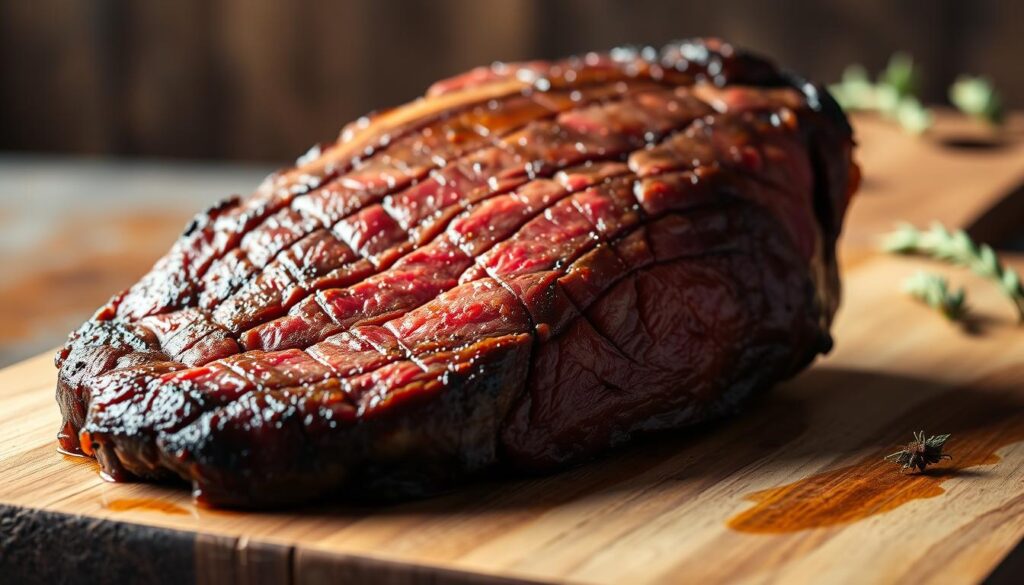
Aging Steaks in a Regular Fridge
Aging steaks in a regular fridge is hard because of humidity issues, contamination risks, and smells. But, it’s doable with the right tools.
Using specialized aging bags or small-scale aging containers helps. These tools control the environment, reducing contamination risks and keeping humidity right.
Other questions include if mold on dry-aged beef is safe, the quality difference between wet-aged and dry-aged beef, and how much trimming is needed. Generally, mold on dry-aged beef is safe if it’s handled and stored correctly. Wet-aged beef can be high quality but has different flavors and textures. Trimming loss from dry-aging varies but is normal.
Additional FAQs
Can all cuts benefit equally from aging? No, not all cuts age well. Cuts with a fat cap, like ribeye or strip loin, age better than lean cuts.
Does grass-fed versus grain-fed beef age differently? Yes, the cattle’s diet affects aging. Grass-fed beef might have a different fatty acid profile, changing aging characteristics.
Are restaurant dry-aged claims always legitimate? Not always. Some restaurants might not be honest about their aging methods. Always ask about their practices if you’re unsure.
Conclusion: Enjoying Your Perfectly Aged Steak
A perfectly aged steak is a true delight for the taste buds. It’s a mix of art and science in meat making. Whether you prefer dry aged or other methods, knowing the details is key.
To make your steak experience even better, try different cuts and aging times. Pair your steaks with sides and wines for a memorable meal. Keeping your steaks stored and handled right is also important.
Practical Tips for Steak Enthuasiasts
When cooking your steak, aim to bring out its natural taste. Think about the steak’s fat and tenderness when choosing how to cook it. This way, you’ll enjoy the steak’s rich flavors fully.
Exploring the World of Aged Steaks
Exploring aged steaks is a journey, not just a destination. By trying new things and recipes, you’ll grow to love the skill behind great steaks.
FAQ
How do I know if a steak is properly aged?
Can I age steaks in a regular fridge?
Is the mold on dry-aged beef safe to eat?
Is wet-aged beef inferior to dry-aged beef?
How much trimming loss can I expect from dry-aging?
Do all cuts of beef benefit equally from aging?
Does grass-fed beef age differently than grain-fed beef?
Are restaurant dry-aging claims always legitimate?
What is dry-aged steak?
What is the difference between dry-aged and wet-aged steak?
How long should I age my steak?
For more cooking tips, stay connected with us. We also recommend the cookbook Skinnytaste Simple: Easy, Healthy Recipes with 7 Ingredients or Fewer
For more Recipes about Beef?
